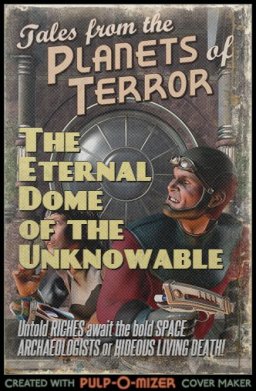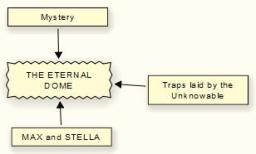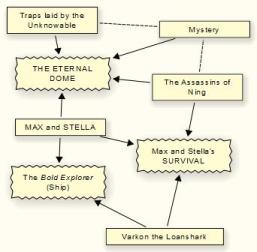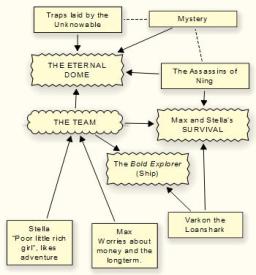Find the Conflict: Unblocking (or Actually Planning!) your NaNoWriMo Novel

Last week, I did a kind of public service announcement about “pantsing”, the “just write” school of writing — discovery writing — applied to your NaNoWriMo novel.
Truth is, I hate pantsing. Pantsing is why my old hard drive had a dozen first three chapters gathering bitrot. The only thing I discovered in several years of writing this way was the need to outline.
OK, there are pros who do pants. However, there are lots of other pros who swear by planning. Not just minor writers like yours truly (bows), but rising stars like my mate Hannu, who is very much a planner and an outliner (though he drafts by hand — hello, the 17th century called ).
Now, NaNoWriMo is all about literary elan; “Get the words down, doesn’t matter how bad.” And if you’re all about the word count, then it’s probably asking a bit much to get you to metaphorically sit on your hands and sketch out your story before pushing out the paragraphs. Even so, there’s a good chance that you’ll write yourself into a corner, or get stuck, run out of plot. Get blocked. So I thought you might find it useful if I shared an approach I used last year when writing novels to order — professionally, my 2013 was like NaNoWriMo does Groundhog Day.
Just to keep me honest, I went over to the Thrilling Tales Derange-O-Lab, generated random pulp titles, picked one that jumped out and built a cover for it (right).
Let’s imagine I’m my 20-something self and this is my NaNoWriMo project, The Eternal Dome of the Unknowable.
So I have some sort of story seed in my head. There’s a couple of freelance Space Archaeologists, Max Fury and Stella “Riches” Ritchey, and they’re looking to plunder investigate the mythical Eternal Dome of the Unknowable, the Unknowable being a lost alien race whose remains are so sparse as to render them… unknowable. (Gamer Dad and I have been playing a lot of Eclipse with our boys.)
So I start writing.

Max and Stella rush to the bedside of an old friend long thought dead and he relates how he reached the fabled dome, but had to flee unspecified terrors and then – driven mad – lived the life of a wandering drifter for half a decade before coming to himself as he succumbs to Altairan Boneworms. The game’s afoot!
Perhaps I could get a bit further than that, but – hey – this is me in my 20s, so let’s agree that I do get stuck and the project dies. It’s always more tempting to write a new first chapter than to slog on through a second chapter when you have No Idea What To Write… or at least that was me back then.
Looking at this stalled project with the benefit of experience, off the top of my head I still have no idea what to write! However, this doesn’t matter because I know how I would approach the problem.
For me, a plot is built out of conflict.
Conflict doesn’t have to be a mysterious, complicated concept. It’s just when two or more forces or people play out some kind of game against each other. Conflict can be artist versus angst, tea blender versus the difficulty of making that herbal tea, midlife crisis dad versus the tempting cheerleaders of suburbia… and of course it can be about brave space archaeologists versus…
And that’s what we need. The versus. Who, what are they up against?

I have a way of exploring this. I call the results “Conflict Diagrams”.
Mine is by no means the only way, for example the FATE Core role playing game recommends a quite different kind of diagramming approach. However, this is what works for me, and by works, I mean helps me free associate, brainstorm, tinker, and find interesting conflicts. I use a simple diagramming tool called Scapple . (I used to use the drawing tool in MS Word. If you have a license for MS Visio, you might prefer to use that. And if you can draw and read your own handwriting, perhaps you want paper and pencil.)
I don’t have many types of boxes, just square boxes for players and jagged boxes for what I call Bones of Contention. These are the things people are fighting over. They tend to generate plots or subplots.
Above right, you can see my first attempt at The Eternal Dome of the Unknowable. The Eternal Dome is obviously the bone of contention, the opposition are the Mystery itself and the traps laid by the mysterious alien Unknowable.

So far, so good. However, it looks just a bit too like a puzzle game. Let’s make their world worse (see left).
I also thought, Let’s have some assassin cult who gets wind of their quest and go after them.
The Assassins of Ning are in some way linked to the Mystery, hence the dotted line. For good measure, I joined the Mystery to the traps, since the traps in some way must illuminate the mystery, or the unraveling mystery helps predict the traps.
Just staring at my screen (listening to Jethro Tull Live At Madison Square Garden recorded when I was my son’s age), I got to think they need to owe money to a Jabba the Hutt figure. Perhaps he has their ship Bold Explorer impounded? If they hightail it across the galaxy, then perhaps he’ll follow, at first because he wants the ship, but soon because he’s curious about what they’re looking for.
It’s looking almost writable now. It would certainly make a nice Diaspora adventure. That should be a clue that it’s missing some characterisation, by which I mean conflicts between the characters. These could get quite complicated. However we don’t have to map them all out, just the ones that provide a focus, the ones that get screen time.
It’s getting on for midnight here in Scotland, so I’ll just stab at the first idea that pops into my head: Max is a hard-working former soldier who worries about his future. Stella is a “poor little rich girl”, disowned by her family, but still doesn’t really take poverty seriously; life is a thrill ride… for now. The idea doesn’t really matter, just the ease with which we can identify and depict them (right). The Team appears on the diagram, as both a Player in its own right and a Bone of Contention, hence the cloud box.
The point is not to use diagramming as a mechanical way to generate plot like some kind of fictioneering Mechanical Turk. Rather the diagrams let me explore the world of my characters. They’re a visualisation tool.
I sometimes use Conflict Diagrams before outlining, sometimes during outlining, never during drafting — because I am not a pantser — but you can use them the same way when you get stuck after the first chapter, or when planning the project. Either way, I find them a handy tool for getting yourself unstuck, or never stuck as you rampage on towards…
…the End.
M Harold Page (www.mharoldpage.com) is a Scottish-based writer and swordsman with several Historical Adventure franchise books in print. His creative writing handbook, Storyteller Tools: Outline from vision to finished novel without losing the magic is available on Amazon. If you live near Edinburgh, Scotland, he would love to teach you how to fight in Medieval German Longsword style.
There’s something very Leigh Brackett about that story. I expect the lead characters to cross path with Eric John Stark any minute.
Now I feel the urge to write it!
If you’re serious, then this should get you going: what sorts of weapons and martial arts do the assassins use?
Ritual throwing stars, each made of exotic material and over a million years old.
Ah, but how would the lighter Martian gravity affect throwing technique?
Well of course. They are mummified undead assassins and unused to other gravities.
I don’t know if you have heard of the snowflake method. I’m going to try it this time around. Thanks for the encouragement. I’ll knock out that novel. I hope you gets some hits. I told the NaNoWriMo buddies that I have about your last two posts.
@Wild Ape – Thanks! Mine is a bit different from the snowflake method because I’m all about telling the story in different levels of detail and trusting your instincts. I suspect my book is also shorter!
(If you want a review copy please pm me mharoldpage at gmail dot com)
[…] into a corner. The best way round this is to consider your conflicts, who the players are, but I’ve talked about that. However, I suspect a lot of people who are stalled have got caught up in a war of attrition with […]
[…] Outliners like me, we write in layers. So my first outline gives me an ending, but the devil is in the details, so the story evolves with the telling. I don’t really know what the ending is until I’ve written actual prose right to the point where I hit enter and type The End. The same is obviously true of Pantsers. […]
[…] into a corner. The best way around this is to consider your conflicts, who the players are, but I’ve talked about that. However, I suspect a lot of people who are stalled have got caught up in a war of attrition with […]
[…] has a post up on the Black Gate website linking to a whole bunch of writing advice posts. This one, Find the Conflict: Unblocking (or Actually Planning!) your NaNoWriMo Novel is a nice overview of how to plan without making an elaborate outline. He includes some screenshots […]